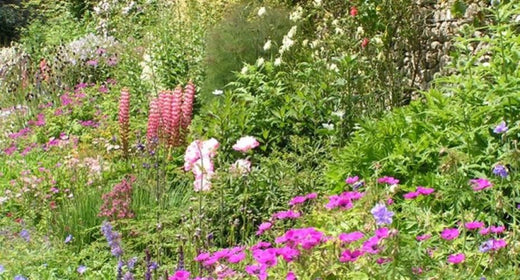A lush, colourful herbaceous border; the epitome of the English garden
Herbaceous border at Sizergh Castle, Cumbria (pictured above)
Planning
- Herbaceous plants perform best in a sunny position out of strong winds, so take this into account when siting your new bed.
- Draw up a rough plan on paper; the shape of the border, how you want the blocks of colour to lie next to each other.
- Make a list of the plants you like and want to include; remember to make sure that they are hardy for your area.
- Besides flower colour also consider leaf shape; grass-like leaves, feathery or large and sculptural. For example, the dark feathery leaves of Sambucus nigra ‘Black Lace’ look fantastic next to the lovely limey/gold leaves of Hakonechloa macra ‘Aureola’.
- Take into account the size of the flower head as well as flower colour; too many tiny flower heads together will look too busy.
- Try and choose some plants which will give architectural seed heads for added winter interest, and to make your own Christmas decorations.
- Plan the flowering period to give you colour from spring to late autumn.

Preparing
- Mark out the shape of the bed with rope or sand.
- Cut off the turf and pile it up out of the way, grass sides together. This will rot down to make fantastic loam which is ideal for sowing seeds and potting on seedlings.
- Preparing the bed well will repay you in the future by providing ideal growing conditions for your plants.
- Double dig the ground; this involves digging down 2 spade depths, really hard work but only needs doing once.
- Put a good layer of well-rotted farmyard manure into the trench before you fill with the earth.
- If you have light sandy soil also incorporate some good quality peat-free compost as well as the manure.
- Remove any perennial weeds, such as dandelions.

Planting
- Plant large shrubs first to give you the structure.
- Plant the herbaceous plants in groups of 3 or 5, small single plants will have no impact and the result will look messy. The exception to this are the large sculptural specimens, such as Cynara cardunculus (Cardoon) and Crambe cordifolia (Flowering Sea Kale), where you will only need one to make an impact.
- Put the plants in position before you plant them to make sure you have enough and that they work well together.
- Check the spread of the plant and leave this distance between the plants, unless you want them to knit together quicker. The closer they are the sooner they will need lifting and re-planting as they will be susceptible to mildew if there is not sufficient air flow.
- If you have gaps in the first year before the plants have knitted together plant bulbs in cheap plastic pots and sink into the border.
For more gardening advice, hints and tips just get in touch with our Outdoor Plant department here in store.


